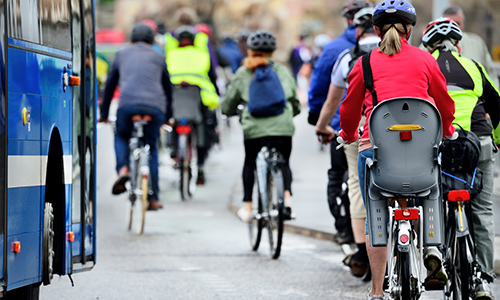How to stay safe on your bike
- Overview
- Full article
For getting your heart pumping, experiencing the great outdoors and sharing good times with friends, there are few sports that match up to cycling. But if you've ever experienced a fall, or witnessed busy city streets, it can be daunting to take to the roads.
Building confidence is key, and confidence comes with feeling safe. So here's my guide to staying safe on your bike.
ROAD SAFETY 101
There are a few basics to remember:
- Never jump road traffic lights or on and off pavements as this could put you or others in danger
- Wear bright clothing to make your presence as visible as possible
- Use lights during the day as well as at night to help you to remain visible to busy traffic
- Wear a helmet, because when you fall off (and everyone falls off) you nearly always hit your head
- Do not use any mobile devices or listen to music when you're cycling. It's important you stay alert and aware
- When approaching roundabouts and busy junctions make sure you make eye contact with the driver before putting yourself across their path. If they have seen you they are not likely to hit you.
SHARING THE ROAD
It's important to acknowledge that you share ownership of the roads with pedestrians and motorists alike. It can be a jostle if you don't take care to both protect your space, and to be respectful of theirs.

Use cycle lanes wherever they exist, and where they don't, ensure that you have enough space between the kerb and your bike (around 1 metre) to turn safely around corners and maintain a buffer against being squeezed closer to the pavement.
If you are approaching a narrow road, road works or crossing a narrow bridge you should put yourself in the middle of your lane to eliminate any chance of someone trying to squeeze past you and putting you in a stressful position.
Always ride confidently with full awareness of your traffic conditions, and always signal your intentions.
BRAKING
Being confident in your brakes is essential for your safety. If it's been a while since you've used your bike, spend a little time refamiliarising yourself on quiet roads. Here are some key things to consider:
- Look ahead and anticipate any obstructions to give you enough time to brake
- Use your front brake with light pressure to control your speed and your rear brake to assist slowing you down.
- Brake smoothly and progressively. Avoid harsh pressure of the front brake which can lead to a fall over your front bars
- Hard braking of your rear wheel can lead to skidding, or the rear wheel sliding away from you, especially on wet or muddy roads
- Practice braking in different situations to learn your limits.
If you are still lacking in confidence after a bit of practice, then you can always speak to professionals. Most local councils have a cycling safety course that they run, or company they work with that does. The Highway Code is also a great reference for the rules of the road.
Last updated Tuesday 6 August 2019
First published on Tuesday 13 September 2016

